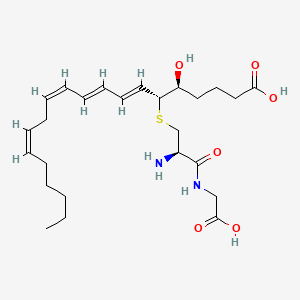| MeSH term | MeSH ID | Detail |
|---|---|---|
| Respiratory Hypersensitivity | D012130 | 18 associated lipids |
| Leukemia, Lymphocytic, Chronic, B-Cell | D015451 | 25 associated lipids |
| Otitis Media with Effusion | D010034 | 9 associated lipids |
| Coronary Artery Disease | D003324 | 47 associated lipids |
| Cough | D003371 | 19 associated lipids |
| Enteritis | D004751 | 8 associated lipids |
| Bronchial Hyperreactivity | D016535 | 15 associated lipids |
| Carotid Stenosis | D016893 | 15 associated lipids |
| Influenza, Human | D007251 | 11 associated lipids |
| Asthma, Exercise-Induced | D001250 | 10 associated lipids |
LTD4
Ltd4 is a lipid of Fatty Acyls (FA) class. Ltd4 is associated with abnormalities such as Inflammatory Bowel Diseases, Inflammatory disorder, Asthma, Pneumonia and Allergic asthma. The involved functions are known as inhibitors, Signal Transduction, Cell Survival, antagonists and Phosphorylation. Ltd4 often locates in Membrane, Tissue membrane, Protoplasm, Cytoplasmic matrix and membrane fraction. The associated genes with LTD4 are ALOX5 gene, UMOD gene, P4HTM gene, RAF1 gene and Homologous Gene. The related lipids are Lipopolysaccharides.
Cross Reference
Introduction
To understand associated biological information of LTD4, we collected biological information of abnormalities, associated pathways, cellular/molecular locations, biological functions, related genes/proteins, lipids and common seen animal/experimental models with organized paragraphs from literatures.
What diseases are associated with LTD4?
LTD4 is suspected in Asthma, Inflammatory Bowel Diseases, Inflammatory disorder, Pneumonia, Allergic asthma, Virus Diseases and other diseases in descending order of the highest number of associated sentences.
Related references are mostly published in these journals:
| Disease | Cross reference | Weighted score | Related literature |
|---|
Possible diseases from mapped MeSH terms on references
We collected disease MeSH terms mapped to the references associated with LTD4
PubChem Associated disorders and diseases
What pathways are associated with LTD4
Lipid pathways are not clear in current pathway databases. We organized associated pathways with LTD4 through full-text articles, including metabolic pathways or pathways of biological mechanisms.
Related references are published most in these journals:
| Pathway name | Related literatures |
|---|
PubChem Biomolecular Interactions and Pathways
Link to PubChem Biomolecular Interactions and PathwaysWhat cellular locations are associated with LTD4?
Visualization in cellular structure
Associated locations are in red color. Not associated locations are in black.
Related references are published most in these journals:
| Location | Cross reference | Weighted score | Related literatures |
|---|
What functions are associated with LTD4?
Related references are published most in these journals:
| Function | Cross reference | Weighted score | Related literatures |
|---|
What lipids are associated with LTD4?
Related references are published most in these journals:
| Lipid concept | Cross reference | Weighted score | Related literatures |
|---|
What genes are associated with LTD4?
Related references are published most in these journals:
| Gene | Cross reference | Weighted score | Related literatures |
|---|
What common seen animal models are associated with LTD4?
There are no associated biomedical information in the current reference collection.
NCBI Entrez Crosslinks
All references with LTD4
Download all related citations| Authors | Title | Published | Journal | PubMed Link |
|---|---|---|---|---|
| Huang SC | Leukotriene-induced contraction is mediated by cysteinyl leukotriene receptor CysLT1 in guinea pig fundus but by CysLT1 and CysLT2 in antrum. | 2011 | Life Sci. | pmid:21396378 |
| Rehni AK and Singh TG | Modulation of leukotriene D4 attenuates the development of seizures in mice. | 2011 | Prostaglandins Leukot. Essent. Fatty Acids | pmid:21641195 |
| Haneda Y et al. | Leukotriene D4 enhances tumor necrosis factor-α-induced vascular endothelial growth factor production in human monocytes/macrophages. | 2011 | Cytokine | pmid:21482134 |
| Daniele S et al. | Agonist-induced desensitization/resensitization of human G protein-coupled receptor 17: a functional cross-talk between purinergic and cysteinyl-leukotriene ligands. | 2011 | J. Pharmacol. Exp. Ther. | pmid:21531793 |
| Cai BL et al. | [Effects of agonist and antagonist of cysteinyl leukotriene receptors on differentiation of rat glioma C6 cells]. | 2011 | Zhejiang Da Xue Xue Bao Yi Xue Ban | pmid:21488208 |
| Itagaki K et al. | Eicosanoid-induced store-operated calcium entry in dendritic cells. | 2011 | J. Surg. Res. | pmid:20080257 |
| Luo H et al. | [Changes of leukotriene D4 in nasal discharge and plasma of patients with persistent allergic rhinitis and the effects of antihistamine]. | 2011 | Lin Chung Er Bi Yan Hou Tou Jing Wai Ke Za Zhi | pmid:21761705 |
| Ni NC et al. | A selective cysteinyl leukotriene receptor 2 antagonist blocks myocardial ischemia/reperfusion injury and vascular permeability in mice. | 2011 | J. Pharmacol. Exp. Ther. | pmid:21903747 |
| Wunder F et al. | Pharmacological characterization of the first potent and selective antagonist at the cysteinyl leukotriene 2 (CysLT(2)) receptor. | 2010 | Br. J. Pharmacol. | pmid:20423349 |
| Woszczek G et al. | Concentration-dependent noncysteinyl leukotriene type 1 receptor-mediated inhibitory activity of leukotriene receptor antagonists. | 2010 | J. Immunol. | pmid:20083671 |
